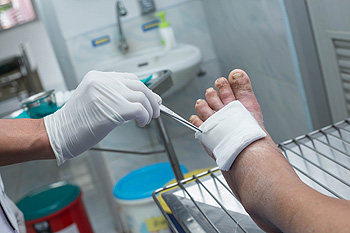Dallas Metro / North Texas
(214) 710-1028
Diabetes and Wound Care
Monday, 29 July 2019 00:00 Research has indicated there are millions of people worldwide who have diabetes. Many of these patients will develop wounds on the feet, which may lead to foot ulcers. It is important to treat these wounds promptly, as this may prevent serious foot conditions from developing. Wound healing may be accelerated when the damaged tissue is removed, and this can be accomplished from a variety of methods. When the correct dressing is applied, the wound can heal and drain properly. Many patients find it necessary to keep pressure off the foot, and this can be accomplished by wearing a boot or a removable cast walker. If you would like additional information on how to care for foot wounds, it is strongly suggested that you schedule a consultation with a podiatrist.
Research has indicated there are millions of people worldwide who have diabetes. Many of these patients will develop wounds on the feet, which may lead to foot ulcers. It is important to treat these wounds promptly, as this may prevent serious foot conditions from developing. Wound healing may be accelerated when the damaged tissue is removed, and this can be accomplished from a variety of methods. When the correct dressing is applied, the wound can heal and drain properly. Many patients find it necessary to keep pressure off the foot, and this can be accomplished by wearing a boot or a removable cast walker. If you would like additional information on how to care for foot wounds, it is strongly suggested that you schedule a consultation with a podiatrist.
Wound care is an important part in dealing with diabetes. If you have diabetes and a foot wound or would like more information about wound care for diabetics, consult with Kellvan Cheng, DPM from Elite Foot & Ankle. Our doctor will assess your condition and provide you with quality foot and ankle treatment.
What Is Wound Care?
Wound care is the practice of taking proper care of a wound. This can range from the smallest to the largest of wounds. While everyone can benefit from proper wound care, it is much more important for diabetics. Diabetics often suffer from poor blood circulation which causes wounds to heal much slower than they would in a non-diabetic.
What Is the Importance of Wound Care?
While it may not seem apparent with small ulcers on the foot, for diabetics, any size ulcer can become infected. Diabetics often also suffer from neuropathy, or nerve loss. This means they might not even feel when they have an ulcer on their foot. If the wound becomes severely infected, amputation may be necessary. Therefore, it is of the upmost importance to properly care for any and all foot wounds.
How to Care for Wounds
The best way to care for foot wounds is to prevent them. For diabetics, this means daily inspections of the feet for any signs of abnormalities or ulcers. It is also recommended to see a podiatrist several times a year for a foot inspection. If you do have an ulcer, run the wound under water to clear dirt from the wound; then apply antibiotic ointment to the wound and cover with a bandage. Bandages should be changed daily and keeping pressure off the wound is smart. It is advised to see a podiatrist, who can keep an eye on it.
If you have any questions, please feel free to contact our office located in Carrollton, TX . We offer the newest diagnostic and treatment technologies for all your foot care needs.
Featured Articles
- April 2025
- March 2025
- February 2025
- January 2025
- December 2024
- November 2024
- October 2024
- September 2024
- August 2024
- July 2024
- June 2024
- May 2024
- April 2024
- March 2024
- February 2024
- January 2024
- December 2023
- November 2023
- October 2023
- September 2023
- August 2023
- July 2023
- June 2023
- May 2023
- April 2023
- March 2023
- February 2023
- January 2023
- December 2022
- November 2022
- October 2022
- September 2022
- August 2022
- July 2022
- June 2022
- May 2022
- April 2022
- October 2019
- September 2019
- August 2019
- July 2019
- June 2019
- May 2019
- April 2019
- March 2019
- February 2019
- January 2019
- December 2018
- November 2018
- October 2018
- September 2018
- August 2018
- July 2018
- June 2018
- May 2018
- April 2018
- March 2018
- February 2018
- January 2018
- December 2017
- November 2017
- October 2017




